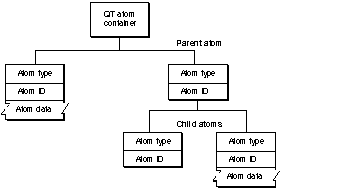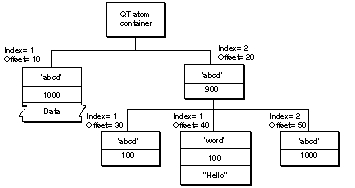
QuickTime 3 Reference
| Previous | Chapter Contents | Chapter Top | Next |
A QT atom container is a basic structure for storing information in QuickTime. You can use a QT atom container to construct arbitrarily complex hierarchical data structures. You can think of a newly-created QT atom container as the root of a tree structure that contains no children. A QT atom container contains QT atoms ( Figure 1-1 ). Each QT atom contains either data or other atoms. If a QT atom contains other atoms, it is a parent atom and the atoms it contains are its child atoms . If a QT atom contains data, it is called a leaf atom .
Figure 1 QT atom container with parent and child atoms

Each QT atom has an offset that describes the atom's position within the QT atom container. In addition, each QT atom has a type and an ID. The atom type describes the kind of information the atom represents. The atom ID is used to differentiate child atoms of the same type with the same parent; an atom's ID must be unique for a given parent and type. In addition to the atom ID, each atom has a 1-based index that describes its order relative to other child atoms of the same parent. You can uniquely identify a QT atom in three ways:
You can store and retrieve atoms in a QT atom container by index, ID, or both. For example, to use a QT atom container as a dynamic array or tree structure, you can store and retrieve atoms by index. To use a QT atom container as a database, you can store and retrieve atoms by ID. You can also create, store, and retrieve atoms using both ID and index to create an arbitrarily complex, extensible data structure.
Since QT atoms are offsets into a data structure, they can be changed during editing operations on QT atom containers, such as inserting or deleting atoms. For a given atom, editing child atoms is safe, but editing sibling or parent atoms invalidates that atom's offset.
For cross-platform purposes, all data in a QT atom is expected to be in big-endian format.
Figure 1-2 shows a QT atom container that has two child atoms. The first child atom (offset = 10) is a leaf atom that has an atom type of 'abcd' , an ID of 1000, and an index of 1. The second child atom (offset = 20) has an atom type of 'abcd' , an ID of 900, and an index of 2. Because the two child atoms have the same type, they must have different IDs. The second child atom is also a parent atom of three atoms.
Figure 2 QT atom container example

The first child atom (offset = 30) has an atom type of 'abcd' , an ID of 100, and an index of 1. It does not have any children, nor does it have data. The second child atom (offset = 40) has an atom type of 'word' , an ID of 100, and an index of 1. The atom has data, so it is a leaf atom. The second atom (offset = 40) has the same ID as the first atom (offset = 30), but a different atom type. The third child atom (offset = 50) has an atom type of 'abcd' , an ID of 1000, and an index of 2. Its atom type and ID are the same as that of another atom (offset = 20) with a different parent.
For more information about the internal structure of QT atoms and atom containers, see the book QuickTime File Format Specification, May 1996.
As a developer, you do not need to parse QT atoms yourself. Instead, you can use the QT atom functions to create atom containers, add atoms to and remove atoms from atom containers, search for atoms in atom containers, and retrieve data from atoms in atom containers.
Most QT atom functions take two parameters to specify a particular atom: the atom container that contains the atom and the offset of the atom in the atom container data structure. You obtain an atom's offset by calling either QTFindChildByID or QTFindChildByIndex . An atom's offset may be invalidated if the QT atom container that contains it is modified.
When calling any QT atom function for which you specify a parent atom as a parameter, you can pass the constant kParentAtomIsContainer as an atom offset to indicate that the specified parent atom is the atom container itself. For example, you would call the QTFindChildByIndex function and pass kParentAtomIsContainer constant for the parent atom parameter to indicate that the requested child atom is a child of the atom container itself.
| Previous | Chapter Contents | Chapter Top | Next |